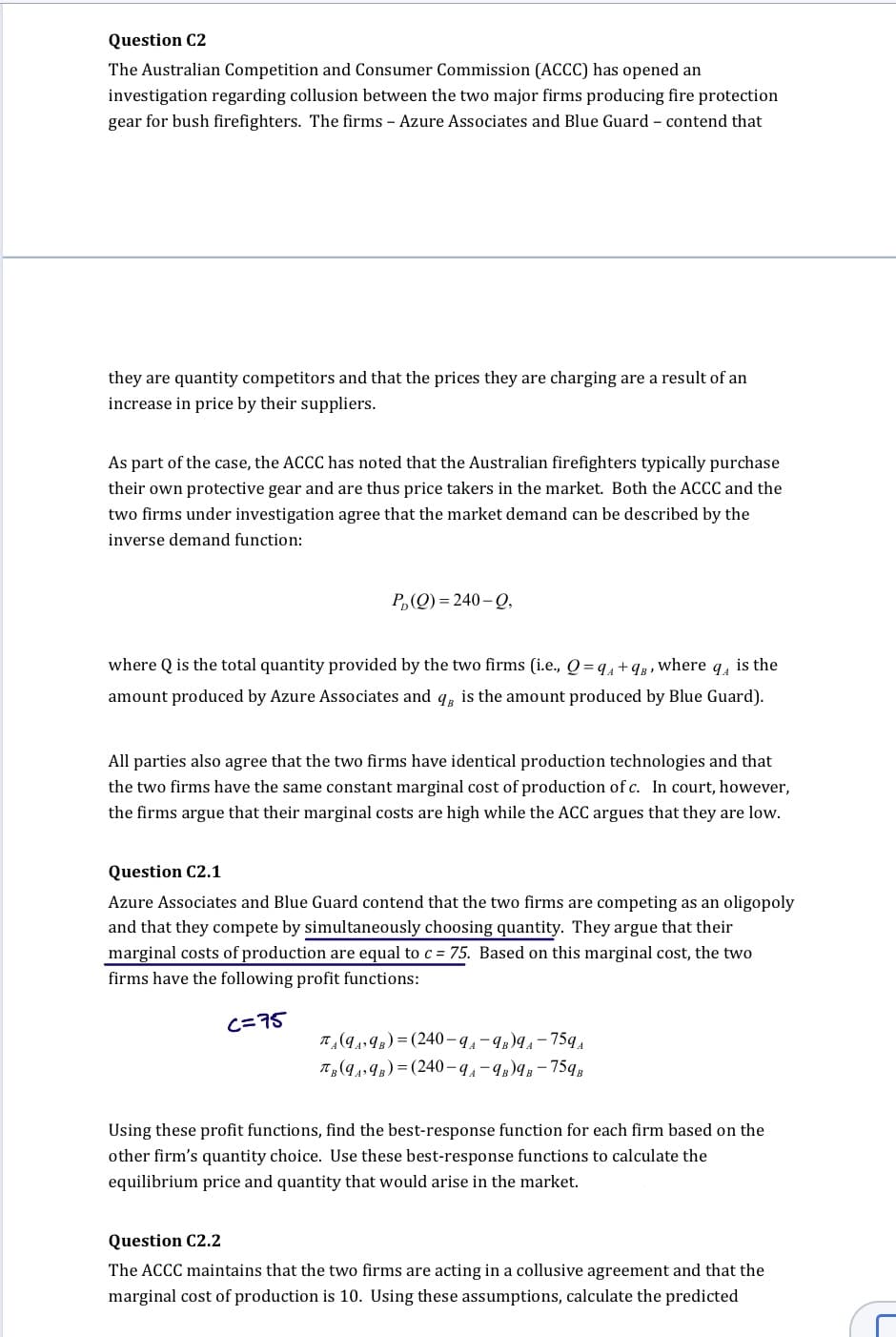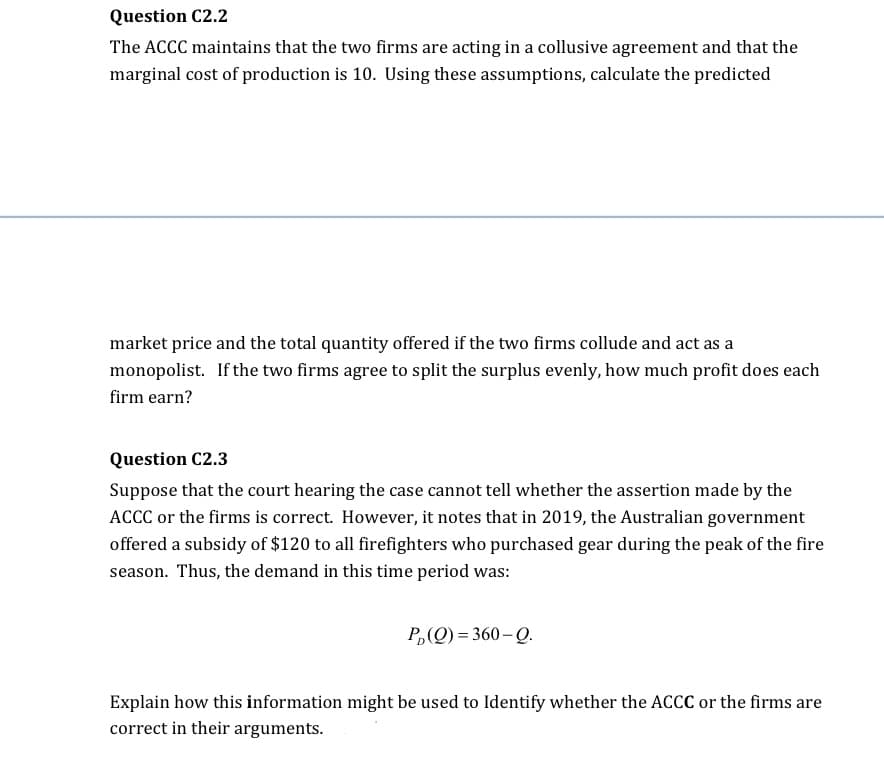Question C2 The Australian Competition and Consumer Commission (ACCC) has opened an investigation regarding collusion between the two major firms producing fire protection gear for bush firefighters. The firms - Azure Associates and Blue Guard - contend that they are quantity competitors and that the prices they are charging are a result of an increase in price by their suppliers. As part of the case, the ACCC has noted that the Australian firefighters typically purchase their own protective gear and are thus price takers in the market. Both the ACCC and the two firms under investigation agree that the market demand can be described by the inverse demand function: P₂(Q)=240-Q, where Q is the total quantity provided by the two firms (i.e., Q=q₁ +98, where q, is the amount produced by Azure Associates and q, is the amount produced by Blue Guard). All parties also agree that the two firms have identical production technologies and that the two firms have the same constant marginal cost of production of c. In court, however, the firms argue that their marginal costs are high while the ACC argues that they are low. Question C2.1 Azure Associates and Blue Guard contend that the two firms are competing as an oligopoly and that they compete by simultaneously choosing quantity. They argue that their marginal costs of production are equal to c = 75. Based on this marginal cost, the two firms have the following profit functions: C=75 (9₁9B)=(240-9₁-98)9₁-759₁ TB (9₁9B)=(240-9A-9B)9B-759B Using these profit functions, find the best-response function for each firm based on the other firm's quantity choice. Use these best-response functions to calculate the equilibrium price and quantity that would arise in the market.
Question C2 The Australian Competition and Consumer Commission (ACCC) has opened an investigation regarding collusion between the two major firms producing fire protection gear for bush firefighters. The firms - Azure Associates and Blue Guard - contend that they are quantity competitors and that the prices they are charging are a result of an increase in price by their suppliers. As part of the case, the ACCC has noted that the Australian firefighters typically purchase their own protective gear and are thus price takers in the market. Both the ACCC and the two firms under investigation agree that the market demand can be described by the inverse demand function: P₂(Q)=240-Q, where Q is the total quantity provided by the two firms (i.e., Q=q₁ +98, where q, is the amount produced by Azure Associates and q, is the amount produced by Blue Guard). All parties also agree that the two firms have identical production technologies and that the two firms have the same constant marginal cost of production of c. In court, however, the firms argue that their marginal costs are high while the ACC argues that they are low. Question C2.1 Azure Associates and Blue Guard contend that the two firms are competing as an oligopoly and that they compete by simultaneously choosing quantity. They argue that their marginal costs of production are equal to c = 75. Based on this marginal cost, the two firms have the following profit functions: C=75 (9₁9B)=(240-9₁-98)9₁-759₁ TB (9₁9B)=(240-9A-9B)9B-759B Using these profit functions, find the best-response function for each firm based on the other firm's quantity choice. Use these best-response functions to calculate the equilibrium price and quantity that would arise in the market.
Principles of Microeconomics (MindTap Course List)
8th Edition
ISBN:9781305971493
Author:N. Gregory Mankiw
Publisher:N. Gregory Mankiw
Chapter17: Oligopoly
Section: Chapter Questions
Problem 9PA
Related questions
Question

Transcribed Image Text:Question C2
The Australian Competition and Consumer Commission (ACCC) has opened an
investigation regarding collusion between the two major firms producing fire protection
gear for bush firefighters. The firms - Azure Associates and Blue Guard - contend that
they are quantity competitors and that the prices they are charging are a result of an
increase in price by their suppliers.
As part of the case, the ACCC has noted that the Australian firefighters typically purchase
their own protective gear and are thus price takers in the market. Both the ACCC and the
two firms under investigation agree that the market demand can be described by the
inverse demand function:
P(Q)=240-Q,
where Q is the total quantity provided by the two firms (i.e., Q=q₁ + 9B, where is the
9A
amount produced by Azure Associates and q, is the amount produced by Blue Guard).
All parties also agree that the two firms have identical production technologies and that
the two firms have the same constant marginal cost of production of c. In court, however,
the firms argue that their marginal costs are high while the ACC argues that they are low.
Question C2.1
Azure Associates and Blue Guard contend that the two firms are competing as an oligopoly
and that they compete by simultaneously choosing quantity. They argue that their
marginal costs of production are equal to c= 75. Based on this marginal cost, the two
firms have the following profit functions:
c=75
TA(9₁9B)=(240-9₁-9B)9₁-759₁
TB (94,9B)=(240-9₁-9B)9B-759B
Using these profit functions, find the best-response function for each firm based on the
other firm's quantity choice. Use these best-response functions to calculate the
equilibrium price and quantity that would arise in the market.
Question C2.2
The ACCC maintains that the two firms are acting in a collusive agreement and that the
marginal cost of production is 10. Using these assumptions, calculate the predicted

Transcribed Image Text:Question C2.2
The ACCC maintains that the two firms are acting in a collusive agreement and that the
marginal cost of production is 10. Using these assumptions, calculate the predicted
market price and the total quantity offered if the two firms collude and act as a
monopolist. If the two firms agree to split the surplus evenly, how much profit does each
firm earn?
Question C2.3
Suppose that the court hearing the case cannot tell whether the assertion made by the
ACCC or the firms is correct. However, it notes that in 2019, the Australian government
offered a subsidy of $120 to all firefighters who purchased gear during the peak of the fire
season. Thus, the demand in this time period was:
P₂(Q)=360-Q.
Explain how this information might be used to Identify whether the ACCC or the firms are
correct in their arguments.
Expert Solution
This question has been solved!
Explore an expertly crafted, step-by-step solution for a thorough understanding of key concepts.
Step by step
Solved in 3 steps with 15 images

Knowledge Booster
Learn more about
Need a deep-dive on the concept behind this application? Look no further. Learn more about this topic, economics and related others by exploring similar questions and additional content below.Recommended textbooks for you

Principles of Microeconomics (MindTap Course List)
Economics
ISBN:
9781305971493
Author:
N. Gregory Mankiw
Publisher:
Cengage Learning

Managerial Economics: Applications, Strategies an…
Economics
ISBN:
9781305506381
Author:
James R. McGuigan, R. Charles Moyer, Frederick H.deB. Harris
Publisher:
Cengage Learning

Economics: Private and Public Choice (MindTap Cou…
Economics
ISBN:
9781305506725
Author:
James D. Gwartney, Richard L. Stroup, Russell S. Sobel, David A. Macpherson
Publisher:
Cengage Learning

Principles of Microeconomics (MindTap Course List)
Economics
ISBN:
9781305971493
Author:
N. Gregory Mankiw
Publisher:
Cengage Learning

Managerial Economics: Applications, Strategies an…
Economics
ISBN:
9781305506381
Author:
James R. McGuigan, R. Charles Moyer, Frederick H.deB. Harris
Publisher:
Cengage Learning

Economics: Private and Public Choice (MindTap Cou…
Economics
ISBN:
9781305506725
Author:
James D. Gwartney, Richard L. Stroup, Russell S. Sobel, David A. Macpherson
Publisher:
Cengage Learning

Microeconomics: Private and Public Choice (MindTa…
Economics
ISBN:
9781305506893
Author:
James D. Gwartney, Richard L. Stroup, Russell S. Sobel, David A. Macpherson
Publisher:
Cengage Learning


Principles of Economics 2e
Economics
ISBN:
9781947172364
Author:
Steven A. Greenlaw; David Shapiro
Publisher:
OpenStax